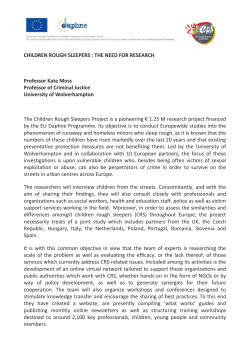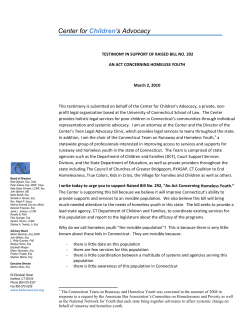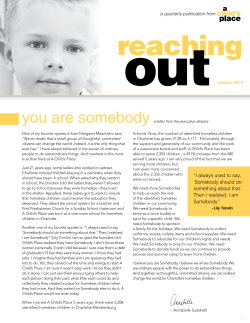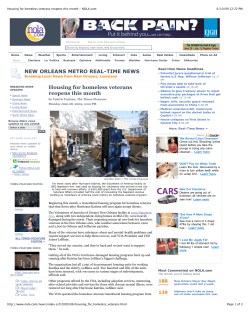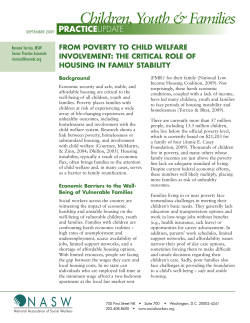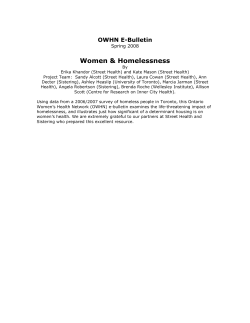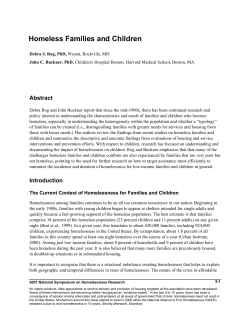
homeless Women The Characteristics of
The Characteristics of HOMELESS WOMEN The United States has the largest number of homeless women among industrialized nations and the highest number on record since the Great Depression.1 Homeless women suffer disproportionately from every catastrophe specific to their gender and race. The problems they experience mirror those of low-income women and are further compounded for women of color. These problems obstruct all women, but not with the same intensity and frequency.2 Each year, more than three million people experience homelessness, including 1.3 million children. Approximately two-thirds of the entire homeless population are individuals, of which 25 percent of are women.3 There are an estimated 11,377 homeless men, women and children in Metropolitan Denver.4 Homeless women make up 45 percent of this population. Why Are Women Homeless? Domestic Violence vvvv “I was pregnant with my second child, and he beat the hell out of me. I was only 98 pounds and pregnant as hell. So that’s how I got on the street. I walked.” —Loretta, 48 vvvv Up to 100 percent of homeless women have experienced domestic or sexual violence at some point in their lives, depending on the region and type of study.5 Violence against women is a principal cause of women’s homelessness. Between 22 percent and 57 percent of homeless women report that domestic or sexual violence was the immediate cause of their homelessness, depending on the region and type of study. In fact, a study that compared both homeless and very poor, housed women found that although violence by intimate male partners was high in both groups, homeless women experienced violence at a higher rate (63.3 percent) than poor, housed women (58 percent).6 More than 36 percent of homeless women said their partner threatened to kill them, compared to 31 percent of housed women. Almost 27 percent of homeless women and 19.5 percent of poor, housed women needed or received medical treatment because of physical violence. Compounding the challenges faced by low-income women in violent relationships are rules that govern public housing. Through a “one strike” policy, women may be evicted for a violent activity regardless of the cause or circumstances.7 Poverty Of the 46.2 million Americans currently living in poverty, almost 25 million or 55 percent are women.8 There has never been a single year on record when women living in poverty did not outnumber their male counterparts. The poverty rate among women climbed to 16.2 percent in 2011 from 13.9 percent in 2009, the highest in 17 years.9 The male poverty rate was lower, rising to 14 percent in 2011 from 10.5 percent in 2009. Over 17 million women lived in poverty in 2010, including more than 7.5 million in extreme poverty, with an income below half of the federal poverty line, defined as $11,139 for an individual. Wage Inequality The typical woman who worked full-time, year-round in 2010 still made only 77 cents for each dollar earned by her male counterpart.10 The wage gap for minority women is even worse. The typical black woman who worked full-time, year-round in 2010 earned Colorado Coalition for the Homeless | January 2012 | 1 less than two-thirds of what her white, non-Hispanic male counterpart did—63 cents for every dollar he made. These gaps translate into a loss of $19,581 for African-American women and $24,224 for Hispanic women every year. The ratio of women’s to men’s earnings for all occupations was 81.2 percent in 2010. For higher paying occupations such as financial advisors, the ratio of women’s to men’s earnings is 58.4 percent. For lower paying jobs such as food preparation, food servers, stock clerks, and social workers, the ratio of women’s earnings is more than 100 percent that of men’s. Therefore, only in occupations that pay significantly less, do women earn more than men. As a result of wage inequality, women own only 36 percent as much wealth as men.11 Additionally, because unemployment benefits are tied to past wages and women’s wages lag behind men’s, unemployed women receive less in unemployment benefits than men.12 vvvv “The maximum rent I could afford is $300 a month, no deposit, utilities included. I’m trying to get a studio apartment, but it’s hard to look for a place. I’m on my feet walking, and some of them have stairs so it’s hard for me to breathe. By the time I stop panhandling and go look, it’s too late, everyone’s gotten the cheap ones. I’m trying to get on the computer, but that’s hard. Everyone’s looking for a place. The first words out of anybody’s mouth on the street are, ‘Do you have a place?’ A place is all we want, even if it’s a hole in the wall, it’s yours. It’s great. You’ve got a place, wow! The lowest prices I’ve found are $425, but that’s for a couple ‘cause no one can afford to do that alone. But they tell you this is only for one person.”—Susan, 42 vvvv In 2009, 903,000 women were employed as cashiers; they earned a median wage of $361 per week.13 Poor, uneducated women do not have a realistic place in the current labor market, designed to support nuclear families with male breadwinners. Many poor women are forced into service sector jobs that do not pay a livable wage or provide necessary benefits. The deep recession that began in December 2007 cost workers nearly 7.5 million jobs before it officially ended in June 2009.14 Overall job growth during the recovery has been weak, adding over 1.4 million jobs between June 2009 and December 2011. It is striking that women did not make any net gains until two and a half years into the recovery and their unemployment rate is higher than it was when the recovery began. Between June 2009 and December 2011, unemployment rates increased for black women (11.6 percent to 13.9 percent) and single mothers (11.7 percent to 12.0 percent). Women’s miniscule net gain in the recovery has been driven by the loss of public sector jobs—women lost 377,000 public sector jobs during the recovery. Lack of Affordable Housing A full 63 percent of extremely low-income renters had severe housing cost burdens (paying more than 50 percent of their income) in 2009, while 50 percent had moderate housing cost burdens (paying 30-50 percent of their incomes).15 Women comprise a disproportionate percentage of households who are cost burdened.16 Additionally, there is an extreme shortage of affordable housing. In Metropolitan Denver, there were 42 affordable units to every 100 households earning $10,000 or less, and 38 affordable units to every 100 households earning $20,000 or less.17 Women without Dependent Children For the purposes of this discussion, women without dependent children are defined as unmarried women without children in their care.18 Women experiencing homelessness are a heterogeneous group in terms of age, race/ethnicity, duration and cause of homelessness. One-third of a nationwide sample of homeless women met all three criteria in the definition of chronic homeless individuals: they had mental health or substance abuse problems; were homeless 365 days or more; and, were unaccompanied individuals.19 Women constitute one out of four chronically homeless adults. Unmarried women—particularly unmarried mothers and the elderly—represent the largest share of adults in need of government services, such as public assistance, housing assistance and food stamps.20 Colorado Coalition for the Homeless | January 2012 | 2 Female Veterans Of the estimated 130,000–200,000 homeless veterans, 13,000 are female, but the number is quickly rising. Just over the past decade, the number of homeless female veterans has doubled.21 Female veterans are up to four times as likely as their male counterparts to be: younger; self-identify as a racial minority; have lower incomes; and, be unemployed. As a result, they are also more likely to become homeless. Experiences of Homeless Women Violence vvvv “I’ve got congestive heart failure and my legs swell up from standing, panhandling. I got blankets, at least I got that much, but other than that, nothing. Absolutely nothing. I’ve got a herniated disk and it’s degenerative. I’ve got sleep apnea and I’m getting worse, I can feel it, it gets a little scary. I’m dying. I have a large heart, so really I’m dying.” —Anne, 59 vvvv A vast majority of women who have been on the streets for longer than six months are likely to have been assaulted and/or raped.22 As an essential survival tactic, homeless women make themselves as invisible as possible so as not to be noticed.23 This survival tactic has practical implications as single, homeless women are also nearly invisible from public view and from media images depicting homelessness. Physical Health Compared to the general population of women, homeless women’s health disparities include higher rates of mortality, poor health status, mental illness, substance abuse, victimization and poor birth outcomes.24 The higher prevalence of illness among homeless women is due, in part, to exposure to the elements, violence, poor nutrition, inadequate social support and infectious diseases.25 Some health problems that disproportionately affect homeless women in comparison to the general population include skin disorders, lacerations, fractures, respiratory ailments, and chronic conditions such as hypertension, diabetes, asthma, anemia and ulcers. Over one-third have a chronic, physical health condition. Homeless women have ulcers at four times the rate of other women. Regarding health care, homeless women are less likely to have a regular source of care, health insurance, cancer screening, adequate prenatal care, appropriate ambulatory care and specialty care for specific disorders.26 Homeless women face obstacles gaining entry to the health care system due to a lack of transportation, insurance, knowledge about where to go and long waits for appointments.27 Mental Health About 50 percent of homeless women have experienced a major depressive episode since becoming homeless.28 Compared to housed women, homeless women have three times the rate of Post Traumatic Stress Disorder (36 percent) and twice the rate of drug and alcohol dependencies (41 percent). Mortality For homeless and marginally housed women, the life expectancy at age 25 is 52 years—seven years lower than the general population, and five years lower than the poorest income group.29 Excess mortality is far greater among homeless women under age 45 than among older homeless women. Mortality rates among younger homeless women often approach or equal those of younger homeless men. In the general population, mortality rates among younger women are one-third to one-half those among younger men. Colorado Coalition for the Homeless | January 2012 | 3 Federal Policy Recommendations Domestic Violence and Sexual Abuse Urge the U.S. Congress to fund the Family Violence Prevention and Services Act (FVPSA), at $140 million, to meet the increasing need for services. It is the only federal funding source dedicated solely to domestic violence shelters and programs.30 FVPSA supports life-saving emergency shelters, crisis lines, counseling, safety planning, legal assistance, and preventative education to millions of adults and children annually.31 In just one day in 2010, 70,648 victims of domestic violence found safety and support from local domestic violence programs and shelters.32 On that same day, however, domestic violence programs were unable to meet 9,541 requests for services, largely due to a lack of resources. vvvv “I worked at Popeye’s. I had three jobs. I just went from one to one, so I took care of the kids the best I could. I did landscaping and sodding. I did construction. . . yeah, I’ve done it all, but cleaning houses is the best. . .but I mean if you get sick you don’t eat. The kids don’t eat.”—Pat, 38 vvvv Reauthorize the Violence Against Women Act (VAWA) that creates and supports comprehensive responses to the crimes of domestic violence, dating violence, sexual assault and stalking. Nearly one in five women have been the victim of rape or attempted rape in their lifetime.33 Nearly one in two women have experienced other forms of sexual violence. In 2010 alone, 1.3 million women have been raped in the United States. VAWA supports critical victim services and criminal justice responses through grant programs such as the Sexual Assault Services Program (SASP) and the Services Training Officers and Prosecutors Program (STOP).The programs of VAWA have dramatically changed federal, tribal, state, territorial and local responses to these crimes. VAWA’s Transitional Housing Program helps meet the ongoing need victims have for safe, affordable housing after leaving emergency shelters to rebuild their lives.34 Expand VAWA housing protections to other federal housing programs so that survivors and their families are not unjustly evicted into homelessness, and include a stronger focus on connecting survivors of domestic violence with permanent housing resources. Income Urge the Senate to pass the Paycheck Fairness Act, a comprehensive bill that would create stronger incentives for employers to follow the law, empower women to negotiate for equal pay, and strengthen federal outreach, education and enforcement efforts. The bill would also deter wage discrimination by strengthening penalties for equal pay violations and by prohibiting employers from retaliating against workers for sharing salary information with their co-workers.35 The legislation would also establish training groups to help women strengthen their negotiation skills, enforce equal pay laws for federal contractors, and require the Department of Labor to work with employers to eliminate wage disparities through better outreach and training. Reauthorize and expand the Workforce Investment Act (WIA), and require state grantees to ensure that homeless women receive job training services designed to help them improve their job skills, maximize their earning potential and place them in decent paying, stable jobs.36 Urge Congress to take action on measures to create jobs for women and men—and to reject further cuts for public services that would mean more job losses and increased hardship, especially for single women and families.37 Colorado Coalition for the Homeless | January 2012 | 4 Housing Support the preservation of critical U.S. Department of Housing and Urban Development (HUD) housing assistance subsidies like Public Housing, Housing Choice Vouchers and Project-Based Section 8 Vouchers that are highly effective in lifting poor women out of poverty. In 2010, 88 percent of all voucher households were elderly, disabled, working or likely to be subject to a work requirement under the Temporary Assistance for Needy Families (TANF) program.38 Support the HUD-Department of Veterans Affairs Supportive Housing (HUD-VASH) Vouchers to provide local public housing agencies with rental assistance vouchers specifically targeted to assist homeless, female veterans and their families.39 Supportive Services and Health Care vvvv “You gotta watch out for people bothering you or tryin’ to take your purse. I’ve had mine taken, with my ID and everything . . . then you gotta worry about somebody raping you if they catch you sleeping in an alley or something. . . I see a lot of homeless women. Some of them get raped, beat up.”—Shirley, 63 vvvv A comprehensive strategy to end female homelessness must address the full range of needs of women experiencing homelessness by providing access to essential female-centered services and supports. This includes access to health care through social networks and advocates in communities and awareness of the specialized health needs of homeless women. Increase funding for Substance Abuse and Mental Health Services Administration (SAMHSA) programs that assist homeless women including: Projects for Assistance in Transition from Homelessness (PATH); the Mental Health Block Grant; and the Substance Abuse Block Grant. Research shows these programs are highly effective and cost-efficient. Promote the integration of behavioral health and primary health care for women in hospitals, Community Health Centers, Health Care for the Homeless Programs and behavioral health clinics. Support female-only, day-time respite care centers and overnight shelters that provide attentive case management and access to mental health and substance abuse services. Competencies in trauma-informed and trauma-specific program models are of utmost importance in ameliorating the plight of homeless women. Planning, Research and Data Collection Implement the U.S. Interagency Council on Homelessness Federal Strategic Plan to Prevent and End Homelessness as it represents an unprecedented opportunity for the federal government to collectively address homelessness. Encourage research on the needs of single, homeless women and how effective programs can best address female homelessness and the associated costs and benefits. Require all studies and programs supported by federal agencies that serve low-income people to collect data on the housing status of program beneficiaries, and ensure that the right questions are asked about the health and safety of women in studies involving homeless populations. Invest in multi-disciplinary research that explores the long-term social and economic costs of female homelessness at individual and societal levels. Colorado Coalition for the Homeless | January 2012 | 5 References 1 The National Center on Family Homelessness. (2011). The Characteristics and Needs of Families Experiencing Homelessness. Available at http://www.familyhomelessness.org/media/147.pdf. 2 Bassuk, E. (1995). Lives in Jeopardy: Women and Homelessness. In C. Willie, P.P Rieker, B. Kramer and B. Brown. Mental Health, Racism and Sexism. Pittsburgh: University of Pittsburgh Press, 237-252. 3 Crossroads Rhode Island. (2011). A report on Women and Homelessness. Available at http://www. crossroadsri.org/Portals/0/Uploads/Documents/Women%20and%20Homelessness.pdf. 4 Metropolitan Denver Homeless Initiative. (2011). Point-In-Time Study, 2011. Available at mdhi.org. 5 National Law Center on Homelessness and Poverty. (2010). Some Facts on Homelessness, Housing, and Violence Against Women. Available at http://www.nlchp.org/content/pubs/Some%20Facts%20on%20 Homeless%20and%20DV.pdf. 6 Bassuk, E. et al. (1996). The Characteristics and Needs of Sheltered Homeless and Low-Income Housed Mothers. Journal of the American Medical Association 276(8): 640-646. Available at http://jama.ama- assn.org/content/276/8/640.abstract. vvvv 7 The National Center on Family Homelessness. (2011). The Characteristics and Needs of Families Experiencing Homelessness. Available at http://www.familyhomelessness.org/media/147.pdf. 8 Crossroads Rhode Island. (2011). A Report on Women and Homelessness. Available at http://www. crossroadsri.org/Portals/0/Uploads/Documents/Women%20and%20Homelessness.pdf. 9 National Women’s Law Center. (2011). Analysis of New 2010 Census Poverty Data—September 2011. Available from http://www.nwlc.org/analysis-new-2010-census-poverty-data-%E2%80%93-september-2011. 10 United States Department of Labor Women’s Bureau. (2011). Giving a Voice to Hope: Assistance for Female Veterans. Available at http://www.youtube.com/watch?v=ynSJtdz8MkI. 11 Chang, M.L. (2010). Shortchanged: Why Women Have Less Wealth and What Can Be Done About It. New York: Oxford University Press. 12 National Women’s Law Center. (2011). Closing the Wage Gap is Especially Important for Women of Color in Difficult Times. Available at http://www.nwlc.org/resource/closing-wage-gap-especiallyimportant-women-color-difficult-times. 13 United States Department of Labor Women’s Bureau. (2011). Giving a Voice to Hope: Assistance for Female Veterans. Available at http://www.youtube.com/watch?v=ynSJtdz8MkI. vvvv 14 National Women’s Law Center. (2012). Modest Recovery Largely Leaves Women Behind. Available at http://www.nwlc.org/resource/modest-recovery-largely-leaves-women-behind. 15 Joint Center for Housing Studies of Harvard University. (2011). The State of the Nation’s Housing. Available at http://www.manausa.com/wp-content/uploads/downloads/2011/06/The-State-Of-The- Nations-Housing-2011.pdf. 16 Merves, E. (1992). Homeless Women. Beyond the Bag Lady Myth. In M. Robertson and M. Greenblatt (Eds.) Homelessness. A National Perspective. New York: Plenum Press, 229-244. 17 Department of Local Affairs, Division of Housing. (2010). Housing Mismatch and Rent Burden Information for Rental Housing in Colorado. Available at dola.colorado.gov. 18 Rosenheck, R. et al. (2007). Special Populations of Homeless Americans. Available at http://aspe.hhs. gov/progsys/homeless/symposium/2-Spclpop.htm. 19 Zlotnick, C. et al. (2010). Long-Term and Chronic Homelessness in Homeless Women and Women with Children. Social Work in Public Health, 25:470-485. 20 Center for American Progress. (2009). Unmarried Women Hit Hard by Poverty. Available at http:// www.americanprogress.org/issues/2009/09/census_women.html. Colorado Coalition for the Homeless | January 2012 | 6 21 United States Department of Labor Women’s Bureau. (2011). Giving a Voice to Hope: Assistance for Female Veterans. Available at http://www.youtube.com/watch?v=ynSJtdz8MkI. 22 Rosenheck, R. et al. (2007). Special Populations of Homeless Americans. Available at http://aspe.hhs. gov/progsys/homeless/symposium/2-Spclpop.htm. 23 Vannueville, M. (2011). Transient Women, Suffering Women, Beyond Appearances: The Association Femmes SDF by their Side. The European Federation of National Organizations Working with the Homeless. Available at http://www.feantsa.org/files/freshstart/Communications/Homeless%20in%20 Europe%20EN/PDF_2010/Homeless%20in%20Europe_Spring10_EN.pdf. vvvv 24 The National Center on Family Homelessness. (2011). The Characteristics and Needs of Families Experiencing Homelessness. Available at http://www.familyhomelessness.org/media/147.pdf. 25 Bassuk, E. et al. (1996). The Characteristics and Needs of Sheltered Homeless and Low-Income Housed Mothers. Journal of the American Medical Association, 276(8): 640-646. Available at http://jama.ama- assn.org/content/276/8/640.abstract. 26 Arangua, L. et al. (2007). Homeless Persons. In Changing the U.S. Health Care System, eds. R.M. Anderson, T.H. Rice and G.F. Kominsky, pp. 481-547. San Francisco: Jossey-Bass. 27 Hatton, D. (2001). Homeless Women’s Access to Health Services: A Study of Social Networks and Managed Care in the U.S. Women’s Health, 33(3): 149-162. 28 Weinreb, L. et al. (2006). A Comparison of the Health and Mental Health Status of Homeless Mothers in Worcester, Mass: 1993 and 2003. American Journal of Public Health, 96(8): 1444-1448. Available at http://www.ncbi.nlm.nih.gov/pmc/articles/PMC1522096/. 29 Cheung, A. et al. (2004). Risk of Death Among Homeless Women: A Cohort Study and Review of the Literature. Canadian Medical Association Journal. Available at http://www.cmaj.ca/content/170/8/1243.full. 30 National Network to End Domestic Violence. (2011). Family Violence Prevention and Services Act. Available at http://www.nnedv.org/policy/issues/fvpsa.html. vvvv 31 Jewish Women International. (2011). The Family Violence Prevention and Services Act. Available at http://www.jwi.org/Page.aspx?pid=1400. 32 National Network to End Domestic Violence. (2010). Domestic Violence Counts 2010: A 24-Hour Census of Domestic Violence Shelters and Services. Available at http://nnedv.org/docs/Census/DV Counts2010/DVCounts10_Report_BW.pdf. 33 National Center for Injury Prevention and Control. (2010). National Intimate Partner and Sexual Violence Survey. Available at http://www.cdc.gov/ViolencePrevention/pdf/NISVS_Executive_Summary-a.pdf. For more information: BJ Iacino Director of Education and Advocacy biacino@coloradocoalition.org 303.285.5223 2111 Champa Street Denver, Colorado 80205 www.coloradocoalition.org 34 National Network to End Domestic Violence. (2011). Reauthorization of the Violence Against Women Act (VAWA). Available at http://nnedv.org/docs/Policy/VAWA_Reauthorization_Fact_Sheet.pdf. 35 National Organization for Women. The Paycheck Fairness Act: The Next Step in the Fight for Fair Pay. Available at http://www.now.org/issues/economic/022709pfa.html. 36 The National Center on Family Homelessness. (2011). 2011-2012 Federal Policy Agenda. Available at http://www.familyhomelessness.org/media/249.pdf. 37 National Women’s Law Center. (2012). Modest Recovery Largely Leaves Women Behind. Available at http://www.nwlc.org/resource/modest-recovery-largely-leaves-women-behind. 38 Center on Budget and Policy and Policy Priorities. (2011). Large Majority of Housing Voucher Recipients Work, Are Elderly, or Have Disabilities. Available at http://www.cbpp.org/research/indexcfm?fa=topic&id=33. 39 The National Center on Family Homelessness. (2011). 2011-2012 Federal Policy Agenda. Available at http://www.familyhomelessness.org/media/249.pdf. Colorado Coalition for the Homeless | January 2012 | 7
© Copyright 2025


